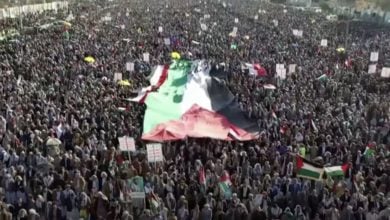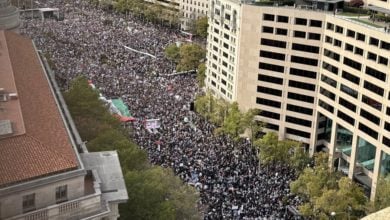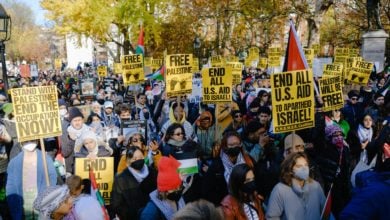Photo: Haitians protest in 2019 in Port-au-Prince. Credit: Alba Movimientos
A series of overlapping crises are afflicting the Haitian people: hunger, spiraling prices and violent paramilitary activity. These dire issues are intensifying the country’s long-running social crisis, created by international and local elites as part of their broader strategy to control and exploit the country.
The ongoing attempts to launch a foreign military intervention and occupation are another in a long line of efforts to smother the popular aspirations of the Haitian people. Over the last 40 years, Haiti has seen two coups, three dictators, two foreign military occupations, multiple death squads, four straight dodgy elections since 2006, one presidential assassination, and a range of exploitative trade deals.
Currently the Caribbean nation appears stuck between a rock and revolution. The rock being a local, regional and international elite desperate to stem the tide of radical energy emanating from Haiti’s working class and peasantry — the potential revolution. The current push for invasion is a counter-insurgency strategy to quell a four-year cycle of mass protest and uprising that works against the advocates of pro-poverty, high-profit policies.
Those who impose this poverty, however, are facing serious challenges in raising an invasion force as most nations, even most of those who are for intervention, fear the vibrant resistance regularly thronging the streets and a highly fractured political atmosphere that make it likely they will face setbacks, losses and humiliation.
The current moment has become a swirl of political actors and potential futures. At stake is whether or not the looting of Haiti can continue unhindered.
Big business backs invasion and occupation
Notably, the invasion call from Haiti’s de facto Prime Minister elicited the support of one of Haiti’s principal business lobbies l’Association des Industries d’Haïti (the Association of Industries of Haiti, ADIH). AIDH1 brings together the business empire of Haiti’s richest man, billionaire Gilbert Bigio, of whom Reuters wrote, “Much of what is bought, sold or consumed in Haiti is likely to touch some corner of the Bigio empire;”2 – with the Apaid family, whose companies employ 21% of Haitian garment workers and control export-oriented agriculture on land stolen from peasants.3 Also present in ADIH is Haiti’s largest fuel company DINASA, owned by French company Rubis4, along with Canadian apparel giant Gildan Brands and CODEVI, the free trade zone that employs another 20% of Haitian textile workers.
Digicell, the Caribbean telecommunications giant owned by Irish billionaire Denis O’Brien is also a member. So is Brasserie Nationale d’Haïti, Haiti’s largest brewer and bottler, now the Haitian outpost of Heineken International. Capital Bank, Haiti’s third-largest, also participates.5
The governments of the United States, Mexico, the United Kingdom and the Dominican Republic have actively promoted intervention, which also has the backing of the Organization of American States.6
Thus the majority opinion of local, regional and international elites who control Haiti’s economy and politics all see their agenda best advanced by foreign military forces.
What power wants to protect
The deep poverty and exploitation experienced by Haitians is the source of billions of dollars of wealth. One-fifth of the country controls 64% of all the wealth.7 Roughly 60% of the population lives on less than $2 a day, and in the nation’s export-oriented trade zones, the minimum wage is $7.50 a day, a level it only reached after workers paralyzed the industry with strikes in early 2022.8
About $21 billion a year in goods and services is generated from this state of affairs.9 The richest ten percent of Haitians control 422% more of the national income than the bottom-half of the country. The top one percent control 28% of wealth, the richest ten percent control 61.7%.10 The import/export sector — so tightly controlled by many of the big conglomerates mentioned above — generates roughly $6 billion a year in income.11
Despite that, two-thirds of the population has only informal employment.12 Only 11% of the rural population has access to electricity, and less than half of those in urban areas have access to improved sanitation.13 Only 50% of children attend school, UNESCO notes that of all the factors leading to “the cost of education stands out,” noting further that: “private schools account for 85% of schooling in the basic education cycle, and even more at secondary level.”14
The people’s resistance
The status quo needs defending because of a four-year cycle of protests that began in 2018 following the sanctions-induced collapse of a Venezuelan subsidized oil program, when the Haitian government under Jovenel Moïse sought to balance the crisis on the backs of the working class and raised the prices of fuel substantially, sparking protests.15 Hundreds of thousands took to the streets across the country.
Massive, sustained mobilizations occurred in November of 2018, in February and November of 2019 and fairly consistently from February 2021 until the current moment.16 A general strike brought the capital to a standstill in October 2018, and in February 2022, workers shut-down the garment sector over poverty wages.17
The protests were often met with violence, and through varying decrees the Moïse regime actually redefined many protest acts as “terrorism” and created incentive structures for police officers to increase their violence against civil society.18 The inability to control the protests was specifically cited by then-President Moïse as a reason why he dissolved parliament and the judiciary and began to rule by decree in dictatorial fashion.19
In December 2020, Moïse doubled down putting in place, in the words of one Haitian editor, “the infrastructure to track, repress, and intimidate the huge demonstrations.”20 In addition to the machinery of the state, Moïse and other Haitian elites have deployed paramilitary forces to try to “repress and intimidate” the huge popular movement.
The gangs of Haiti
The “gangs” of Haiti are more like paramilitaries, with significant ties to Haiti’s elites and security forces. For instance, on Oct. 12, the Ti Bwa “gang” attacked a police station and stole “among other things, an armored vehicle, a machine gun and other firearms.” Notably, however, Ti Bwa is also known for “collaborating with the police … an ally of the PNH in the fight against the gangs of Grand-Ravine and Village de Dieu.”21
Shortly before his murder, one gang-leader alleged he was working directly for the owner of one of Haiti’s largest importers.22 Lafito Port, a private port owned by Haiti’s richest man Gilbert Bigio and his GB Group, has been the site of multiple weapons seizures23 as has the privately owned Caribbean Port Services that facilitates a huge amount of shipping into the capital.24 One businesswoman told the Associated Press that: ““some businesses decide to have their own gangs on payroll. And that choice is the story of many companies in Haiti.”25
Youri Mevs, from one of Haiti’s richest families and owners of Shodecosa, Haiti’s largest industrial park, which warehouses 93 percent of Haiti’s imported food, openly admitted to AP of boosting rival gangs to obtain the best possible leverage over them all.26 Even the State Department admitted “political, economic, social elites are behind the scenes supporting these gangs,” this includes some the U.S. is openly meeting with, ironically enough, about addressing gang violence.27
To hide this broader reality, the elite interests who run Haiti have tried to center anger over paramilitary violence on the leader of one “gang” the G9, led by the now notorious Jimmy “BBQ” Chérizier. He is presented as the source of all of Haiti’s immediate problems and has been targeted by U.S. and UN sanctions.
To the stalwart radical Haitian newspaper Haiti Liberte, Chérizier has maintained that he is a “revolutionary.” To the Associated Press he claimed to be inspired by the late dictator “Francois ‘Papa Doc’ Duvalier, who ruled Haiti with bloody brutality from 1957 to 1971 and had himself declared ‘president for life.’”28
He told Al Jazeera that, “It’s the system I’m fighting against.”29 Yet he also backed President Jovenel Moïse’s sham referendum in 2021, threatening a “civil war”30 if it did not take place. Additionally, “BBQ,” in early October, released political demands that supported Ariel Henry continuing as prime minister.31 The G9 gang federation was also formed when Moïse’s own “Commission for Disarmament” had a dialogue with Chérizier, which, at least some sources suggest, speaks to a broader pattern of interaction between Chérizier and Moïse’s PHTK party.32
On balance, it seems fairly clear that Chérizier is an opportunist, using his armed strength to pursue various accommodations with power, while alternating between the use of violence, coercion and rhetoric to appeal to some section of the popular masses.
By focusing almost everything on Chérizier and a handful of other corrupt figures in the political world, the broader elite nexus evades accountability, separating themselves from a “few bad apples.”
‘Gangs’ as counterinsurgency
From the beginning, elites have sponsored armed groups as a method of suffocating this popular uprising and, notably, the rise of “gang violence” in Haiti tracks closely with the rise of the protest movement. On October 17, 2018, some of the largest protests in Haiti’s history took place. A large part of the mobilization emanated from the working-class neighborhood of La Saline in the capital of Port-au-Prince. Roughly a month later, “gangs” reputedly linked to Jovenel Moïse massacred at least 71 in La Saline.
Bel Air is another working-class area of the capital, also known for being a stronghold of protests against the neo-colonial status quo. In the fall of 2019, residents of Bel Air engaged in a range of protests and blockades as part of a general strike of sorts. Appeals from the government to lift these measures failed around Oct. 31 to Nov. 3. Then, on Nov. 4, 24 Bel Air residents were killed in an attack by a “gang” also reputedly linked to the Moïse regime.33
In June 2020, major fighting between “gangs” raged in Cité Soleil, 111 died over about a month of fighting. The clashes targeted areas of the neighborhood known for being particularly supportive of anti-Moïse activity, and, once again, the “gangs” at issue are alleged to have had ties to the Moïse regime.
However, the counterinsurgent antics of Moïse and other elites have not quelled the protest. Moïse himself was assassinated attempting to further consolidate his rule by using corruption and drug trafficking charges to try to sideline many powerful oligarchs.34
Henry’s government was then installed35 to defend this high-poverty, high-profit status quo by continuing to repress the protests while maintaining the collective dictatorship of Haitian elites who were not willing to be displaced as interlocutors to regional and international capital by Moïse.
Center(s) of power
Unable to quell the popular resistance purely with paramilitary activity and unable to form a durable political consensus the de facto government is seeking to break a political logjam with an invasion. This has created a political scene fractured along multiple lines between the dictatorial government, their elite backers and various paramilitaries on the one hand, and between a popular movement with multiple “centers of power” on the other.
There are several initiatives seeking a resolution to the crisis emerging from the broad protest movement and presenting various transitional agendas. Looming largest is a grouping known as the “Montana Accord.” The Accord is a broad civil society platform that brought together a subset of long-time elite political figures, the major religious organizations, nearly 20 political parties, elements of the anti-Imperialist/socialist left (notably the socialist party Rasin Kan Pèp La).36
Fanmi Lavalas, the former left-leaning ruling party and one of its larger splinters, Parti Pitit Desalin, led by Senator Moïse Jean-Charles, have also been mobilizing their bases in the mass movement and also have presented their own transitional plans. Anti-imperialist groups like the National Movement for Liberty and Equality of Haitians for Fraternity (MOLEGHAF) and others continue to mobilize heavily against the de facto government of Henry and the idea of intervention in Haiti as well.
Many of these organizations have contributed to the resistance on the ground that is making the prospect of invasion more difficult. This, however, leaves the future deeply uncertain as it seems there is no broad consensus among elites, or the masses on how to resolve the crisis. The one certainty seems to be, however, that Haitians will not accept even more neo-colonial devastation.
Sources
- https://lenouvelliste.com/article/238565/le-secteur-prive-supporte-les-demandes-daide-securitaire-et-humanitaire-du-gouvernement-henry
- https://www.flcourier.com/news/nation/pandora-papers-show-how-wealthy-elite-hide-their-fortunes/article_e6521832-28ed-11ec-9d65-237d835ded39.html
- https://gmczf.com/about-us/; https://www.youtube.com/watch?v=iQb8diRqKys
- https://www.dinasa.ht/about
- https://adih.ht/fr/membres/
- https://documents-dds-ny.un.org/doc/UNDOC/PRO/N22/634/46/PDF/N2263446.pdf?OpenElement; https://www.washingtonpost.com/opinions/2022/10/11/haiti-intervention-united-nations-democracy/; https://www.oas.org/en/media_center/press_release.asp?sCodigo=E-045/22
- https://borgenproject.org/tag/income-inequality-in-haiti/
- https://borgenproject.org/facts-about-poverty-in-haiti-2/; https://www.cnn.com/2022/02/21/business/haiti-minimum-wage-raise/index.html
- https://data.worldbank.org/indicator/NY.GDP.MKTP.CD?locations=HT
- https://wid.world/country/haiti/
- https://oec.world/en/profile/country/hti
- https://borgenproject.org/facts-about-poverty-in-haiti-2/
- https://publications.iadb.org/publications/english/document/Estimating-and-Forecasting-Income-Poverty-and-Inequality-in-Haiti-Using-Satellite-Imagery-and-Mobile-Phone-Data.pdf
- https://www.iiep.unesco.org/en/dropping-out-school-unwelcomed-trend-haiti-13528
- https://www.reuters.com/article/haiti-fuel/rpt-feature-row-with-u-s-energy-trader-worsens-haitis-fuel-crisis-idINL1N21W06P; https://haitiliberte.com/haitian-demonstrators-ask-where-is-the-petrocaribe-money/; https://www.france24.com/en/20200817-petrocaribe-scandal-haiti-court-accuses-officials-of-mismanaging-2-bln-in-aid
- https://en.wikipedia.org/wiki/2018–2022_Haitian_protests#cite_note-NYT_231118-22
- https://www.aljazeera.com/news/2021/10/18/haitians-strike-to-protest-insecurity-us-seeks-hostages-release; https://www.cnn.com/2022/02/21/business/haiti-minimum-wage-raise/index.html
- http://hrp.law.harvard.edu/wp-content/uploads/2021/04/Killing_With_Impunity-1.pdf
- https://www.reuters.com/article/us-haiti-politics/haiti-opposition-condemns-countrys-slide-into-rule-by-decree-idUSKBN1ZE098
- https://haitiliberte.com/loyal-to-washington-new-police-chief-leon-charles-specializes-in-counter-insurgency-intelligence-gathering-and-repression/
- https://lenouvelliste.com/article/238542/des-bandits-se-saisissent-dun-vehicule-blinde-et-de-mitrailleuses-de-la-pnh-a-martissant
- https://jafrikayiti.com/confessions-of-haitian-kidnapper-arnel-joseph/
- https://www.haitilibre.com/en/news-19842-haiti-flash-new-weapons-seizure-at-port-lafiteau.html
- https://www.haitilibre.com/en/news-37154-haiti-flash-seizure-of-weapons-and-ammunition-imported-under-cover-of-the-franchise-of-the-episcopal-church-of-haiti.html
- https://apnews.com/article/business-caribbean-port-au-prince-haiti-only-on-ap-fc8acb709b09f75b7783e9fab45e830d
- Ibid.
- https://www.wlrn.org/news/2021-11-23/u-s-diplomat-helping-haiti-rebuild-its-police-elites-tied-to-gangs-are-on-notice
- https://www.pbs.org/newshour/world/whos-behind-haitis-powerful-gang-alliance
- https://www.aljazeera.com/news/2022/10/21/who-is-haitis-sanctioned-gang-leader-jimmy-barbecue-cherizier
- http://www.ijdh.org/wp-content/uploads/2021/06/June-2021-Human-Rights-Update-IJDH.pdf
- https://docs.google.com/document/d/1W22kungzC4IkRa_oGWnVQG8jAjFI9tfCAIleyPZzG8Q/edit?usp=sharing
- http://woymagazine.com/2020/09/18/what-is-happening-in-the-neighborhood-of-belair/; https://web.rnddh.org/wp-content/uploads/2020/06/7-Rap-Attaque-Quartiers-Defavorise-Version-Anglaise-23Jun2020-2.pdf
- http://hrp.law.harvard.edu/wp-content/uploads/2021/04/Killing_With_Impunity-1.pdf
- https://www.nytimes.com/2021/12/12/world/americas/jovenel-moise-haiti-president-drug-traffickers.html
- https://www.cbc.ca/news/politics/core-group-ariel-henry-support-1.6106993
- https://haitiantimes.com/2022/10/03/haitis-montana-accord-document/






